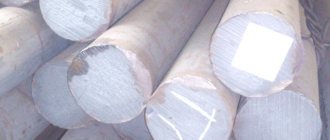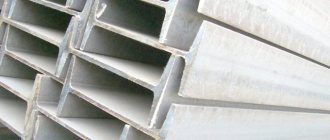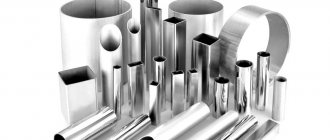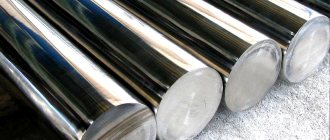Classification of quality carbon steels
High-quality carbon steels and structural steels can be classified according to the following criteria:
- By purpose:
- for use in mechanical engineering;
- for use in construction;
- According to the amount of impurities that reduce quality:
- ordinary quality;
- quality;
- High Quality;
- especially high quality;
- By composition:
- presence of carbon: low carbon;
- medium carbon;
- high carbon;
- low alloy;
- By delivery method:
- forged;
- rolled;
- calibrated;
- By processing:
- ordinary;
- boiler rooms;
- automatic;
- According to the degree of deoxidation:
- boiling (kp);
- semi-calm (ps);
- calm (no designation).
Visual classification of steel types
Deoxidation affects the homogeneity of the internal structures of the metal. The best in terms of homogeneity is calm (a, d), followed by semi-calm (c, f) and lower quality boiling (b, e). The internal structure is clearly shown in the figure.
Diamond
It is a metastable mineral that can exist indefinitely, due in part to the strength and density of carbon. Diamond is the hardest substance on the Mohs scale and cuts glass easily.
It has high thermal conductivity, dispersion, and refractive index. It is wear-resistant, and to make it melt requires a temperature of 4000 °C and a pressure of about 11 GPa. Its peculiarity is luminescence, the ability to glow in different colors.
This is a rare, albeit common substance. The age of minerals, according to certain studies, can range from 100 million to 2.5 billion years. Diamonds of extraterrestrial origin, perhaps even presolar, have been discovered.
This mineral has found its application in jewelry. A cut diamond, called a diamond, is expensive, but its precious status and beauty have made it even more popular. By the way, this substance is also used in the manufacture of cutters, drills, knives, etc. Due to its exceptional hardness, the mineral is used in many industries.
General characteristics of high-quality carbon steels
The main differences between high-quality steels and ordinary quality steels are:
- a small amount of quality-reducing impurities: sulfur and phosphorus;
- narrow range of carbon amounts;
- increased amount of manganese or silicon.
The steel is supplied from the manufacturer with a guarantee of the declared composition of chemical elements and their inherent mechanical properties.
Speaking about the characteristics of high-quality steels, the most significant ones should be highlighted:
- high strength;
- plastic;
- impact viscosity.
Changes in the structure of steel ingots during hardening
But to improve performance characteristics, employees of institutes and laboratories are experimenting with the chemical composition, methods of increasing the strength and hardness of surfaces, heat treatment methods, and methods of melting and casting metal. The mechanical properties of high-quality carbon alloys depend on the chemical composition.
Properties inherent in carbon alloys:
- Low carbon – low strength with high ductility. They are used in the production and manufacture of parts and assemblies with complex structures and light loads. Properties inherent in carbon alloys:
- 15-20 – for non-critical parts that do not require additional heat treatment or have been subjected to normalization.
- Medium carbon - for the manufacture of parts that require high hardness, but with reduced ductility. Products that require heat treatment: hardening of the surface layer, improvement, normalization. To facilitate cutting, medium carbon steels are annealed.
- High-carbon, as well as with additionally introduced manganese, have high elasticity and wear resistance. Therefore, spring products are made from it.
- Automatic – used for processing on automated machines. Phosphorus and sulfur in greater quantities contribute to the formation of small chips, which has a positive effect on the machinability and durability of the tool, but the roughness of the machined surfaces suffers.
Download GOST 1050-88
Chemical-thermal effect
Carbon and alloy steels can be subjected to special types of processing.
One of them is carburization, a process that is the diffusion saturation of the surface layer of steel with carbon when heated in an appropriate environment. The ultimate goal of the operation is to obtain high surface hardness and wear resistance with a tough core. Cementation can also occur in a solid carburizer, which is a mixture of charcoal and carbon dioxide salts.
Nitriding of steel is a process that involves diffusion saturation of the surface layer of steel with nitrogen. This procedure is carried out in an ammonia atmosphere at a temperature in the range of 500-700 degrees Celsius. Nitriding is carried out to obtain a surface of the part that is resistant to wear and corrosion and has great hardness.
Boriding - the top layer of steel is saturated with boron. This is done to increase wear resistance, heat resistance and hardness.
Also, to obtain heat-resistant surfaces, aluminizing is used - saturating steel with aluminum.
Use of high-quality structural carbon steel
The scope of application is quite wide. The main consumers of alloys are the engineering and construction industries. One of the advantages is considered to be good weldability.
As the name suggests, “structural” means used for building metal structures. Another name is reinforcing steel.
Considering the main grades of quality steel used by industrial enterprises, they can be divided by purpose.
- High-quality low-carbon steels 05-10. Their main purpose is the production of responsible and high-quality structures using welding (increasing the amount of carbon helps to reduce weldability). A small amount of carbon after welding does not provoke the formation of cracks in both hot and cold conditions.
- High-quality low-carbon steels 12-20. Their main purpose is the production of structural elements and parts that are not critical, lightly loaded, and subsequently cemented. Processed by cutting, cold stamping, complex drawing. Surface requirements: wear resistance, high hardness with a soft core. We manufacture mechanical engineering elements (shaft, axle, bolt, coupling, fork, lever, flanges and others), as well as elements of boiler equipment operating at high pressure and temperatures from -40°C to 450°C (pipeline, tee, connecting flange and others).
- High-quality medium carbon steels 25-35. Parts made from this material operate under medium loads and low stresses. After chemical-thermal exposure, they have high strength of the surface layer, wear resistance, but with insignificant strength of the core of the part (nut, screw, pawl, hook, cam, sprocket, etc.).
- High-quality medium carbon steels 40-45. After heat treatment, products made from this material can withstand medium loads (shaft, gear, connecting rod, etc.) well. To obtain blanks, the method of hot die stamping is used. Subject to all methods of heat treatment. In all medium-carbon steels, after quenching and subsequent high tempering, the internal structure becomes tempered sorbitol. In connection with this, viscosity increases with plasticity, and this means low sensitivity of stress concentrators. As the diameter of the product increases, its hardenability decreases.
- High-quality medium carbon steels 50-55. Parts made from these steels are highly loaded elements of mechanisms and assemblies (clutch, gear, spring ring, etc.).
- High-quality high-carbon steels 60-80 (G). Parts are manufactured that are subjected to constant compression stresses, which are operated under friction conditions (eccentric, spring, spring, etc.), as well as those operating under heavy dynamic and static loads (torsion bar, cross).
- High-quality boiler steel 12K-22K. They are used in the manufacture of parts whose operation involves elevated temperatures and high pressure. To improve weldability, titanium is introduced into the composition, and deoxidation is carried out by aluminum. Vessels and boilers that work with turbines, combustion chambers on ships and steam units are made from it.
- Automatic steel. Widely used in the industrial production of fasteners for automobiles and assemblies operating under static loads (bolt, nut, stud).
Production
The metallurgical industry produces metal alloys. The specificity of the process for producing carbon steel is the processing of cast iron billets with the reduction of suspended matter such as sulfur and phosphorus, as well as carbon, to the required concentration. The differences in the oxidation technique by which carbon is removed allows us to distinguish different types of smelting.
Oxygen converter method
The basis of the technique was the Bessemer method, which involves blowing air through liquid cast iron. During this process, carbon is oxidized and removed from the alloy, after which the iron ingots gradually turn into steel. The productivity of this technique is high, but sulfur and phosphorus remained in the metal. In addition, carbon steel is saturated with gases, including nitrogen. This improves strength but reduces ductility, making the steel more prone to aging and high in non-metallic elements.
Given the low quality of steel produced by the Bessemer method, it was no longer used. It was replaced by the oxygen-converter method, the difference of which is the use of pure oxygen, instead of air, when purging liquid cast iron. The use of certain technical conditions during purging significantly reduced the amount of nitrogen and other harmful impurities. As a result, carbon steel produced by the oxygen-converter method is close in quality to alloys melted in open-hearth furnaces.
The technical and economic indicators of the converter method confirm the feasibility of such smelting and make it possible to replace outdated methods of steel production.
Open hearth method
A feature of the method for producing carbon steel is the burning of carbon from cast iron alloys not only with the help of air, but also by adding iron ores and rusty metal products. This process usually takes place inside furnaces, to which heated air and combustible gas are supplied.
The size of such melting baths is very large; they can hold up to 500 tons of molten metal. The temperature in such containers is maintained at 1700 ºC, and carbon burning occurs in several stages. First, due to excess oxygen in flammable gases, and when slag forms above the molten metal, through iron oxides. When they interact, slags of phosphates and silicates are formed, which are subsequently removed and the steel acquires the required quality properties.
Steel melting in open hearth furnaces takes about 7 hours. This allows you to adjust the desired composition of the alloy when adding different ores or scrap. Carbon steel has long been manufactured using this method. Such stoves, in our time, can be found in the countries of the former Soviet Union, as well as in India.
Electrothermal method
It is possible to produce high-quality steel with a minimum content of harmful impurities by melting it in vacuum furnaces of electric arc or induction furnaces. Thanks to the improved properties of electric steel, it is possible to produce heat-resistant and tool alloys. The process of converting raw materials into carbon steel occurs in a vacuum, due to which the quality of the resulting workpieces will be higher than the previously discussed methods.
The cost of such metal processing is more expensive, so this method is used when there is a technological need for a high-quality product. To reduce the cost of the technological process, a special ladle is used, which is heated inside a vacuum container.
Marking features
An alphanumeric index is used for designation. The numbers indicate the percentage of carbon content (0.00%). The letters (kp, ps or sp) indicate the degree of deoxidation, the increased amount of manganese (G), aluminum (U), vanadium (F) and the processing method. The letter A in front of the numbers indicates an automatic alloy, the letter K after the numbers means a boiler alloy, PV is made by hot rolling, OSV is a metal for the production of railway car axles. To designate high-quality steels, in contrast to ordinary quality, “Steel” is written before the marking.
Examples:
- Steel 10. Carbon content is about 0.1%, the degree of deoxidation is calm.
- Steel 10 kp. The carbon content is about 0.1%, boiling according to the degree of deoxidation.
- Steel 20G. Carbon content is about 0.2%, manganese up to 1%.
- Steel 30G2. Carbon content is about 0.3%, manganese up to 2%.
- Steel A20. Automatic with an average carbon content of about 0.2%.
- Steel 20K. Boiler room with an average carbon content of about 0.2%.
| Structural high-quality carbon steel, grades, GOST standards. standards | ||
| Russia, GOST 1050-88 | USA, AISI | EU, DIN |
| Steel 08 kp | A622 | Fe P04/St 14 |
| Steel 10 | A1010 | 1.0301 |
| Steel 15 | A1015 | 1.0401 |
| Steel 25 | A1025 | 1.1158 |
| Steel 20K | A285-A | Р265GH |
Foreign manufacturers of similar products produce labeling according to their own standards.
Use in construction industry
For structural steels that are purchased for use in construction, you should choose options with a low content of alloying components (silicon, chromium, manganese). Carbon should be 0.1 - 0.2%. This composition allows you to achieve high-quality connection of parts during welding. Features useful for the functional characteristics of construction buildings also appear. These include:
- malleability, viscosity;
- relative stretch;
- density of the crystal lattice structure, viscosity.
The choice for the industry associated with construction types of work in favor of low-alloy steels makes it possible to invest less money on the necessary raw materials. The savings percentage can be up to a third of what is needed. Alloying increases the degree of hardening, and the yield limit parameter also increases.
The most popular categories of the described steels, which come into production in the form of long metal, sheets, strips and rods, include options 14G2; 15HSND; 10G2S1; 18G2; 25G2S; 35GS.







